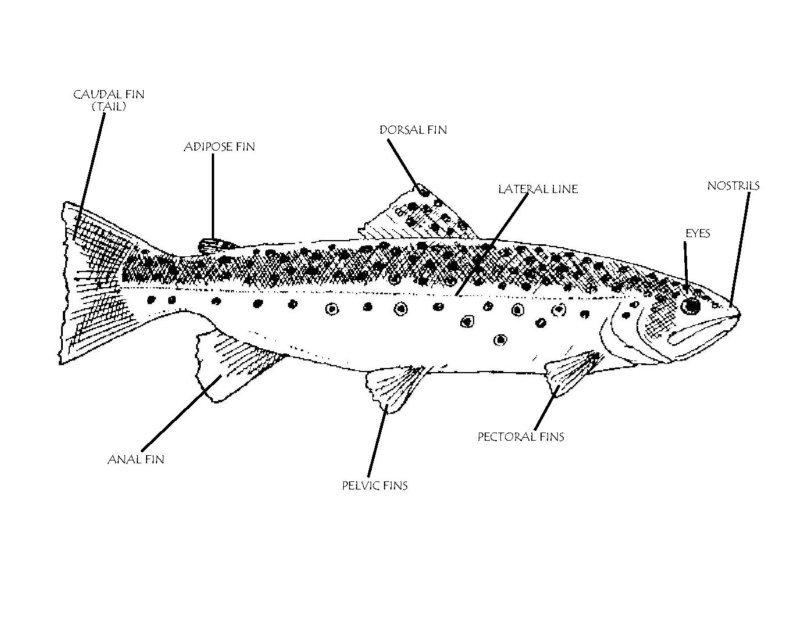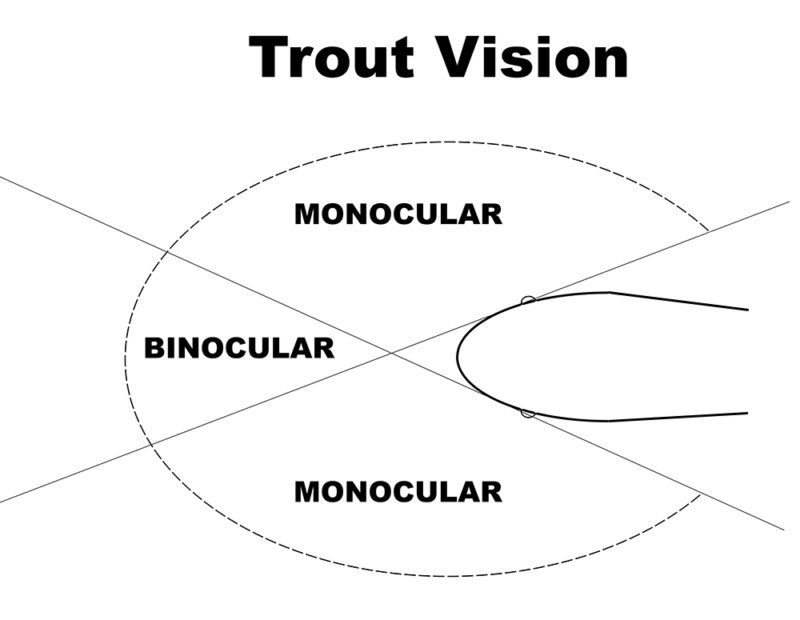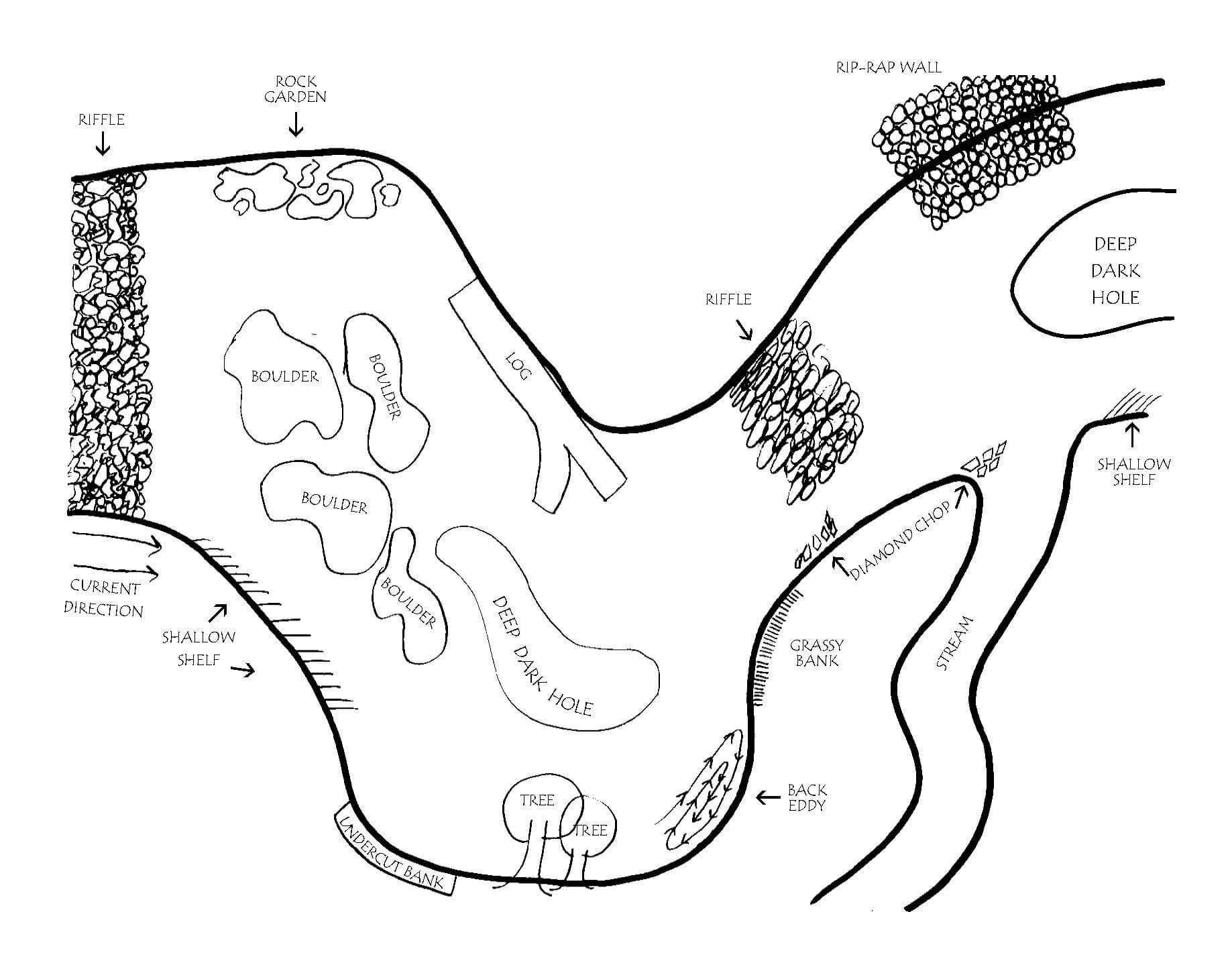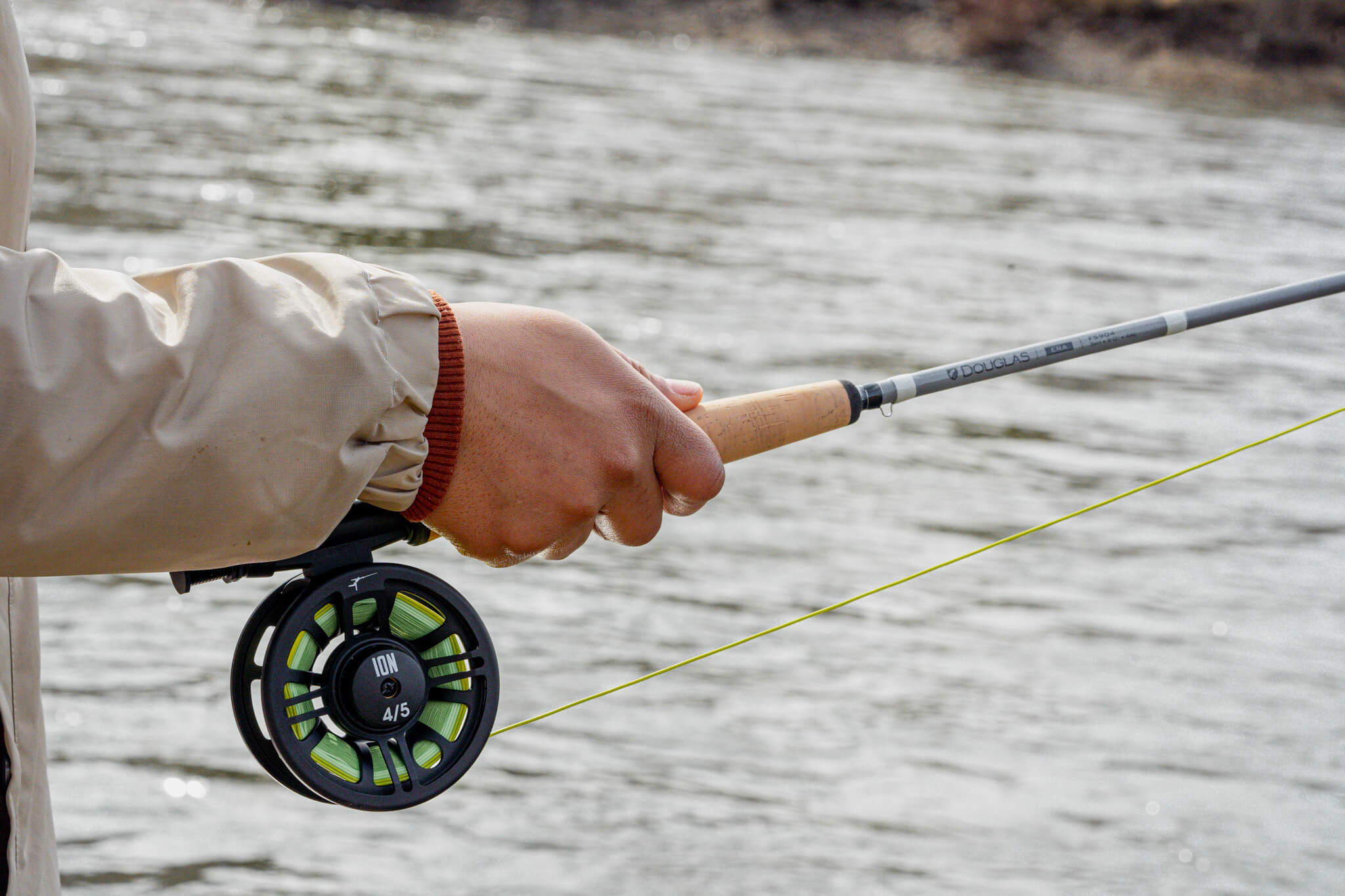What is a Trout?

What is a Trout? Scientifically, this is a trout.
- Kingdom: Animalia (animals)
- Phylum: Chordata (animals with notochords and hollow nerve chords)
- Sub-phylum: Vertebrata (animals with backbones)
- Class: Osteichthes (bony Fishes)
- Order: Salmoniformes (fishes with soft rayed fins, adipose fins and abdominal pelvic fins)
- Family: Salmonidae (Trout, salmon, char, whitefish, grayling)
- Sub-family: Salmoninae (trout, salmon, char)
Does that help you in any way? No. But we thought you should know that we know what a trout is!
The short answer is, it’s a fish. To be exact, it’s a fresh water, cold blooded fish found in moving and still water that has very specific characteristics capable of supporting trout and the food they feed on.
But that’s much less important to the angler. As anglers, we need to understand trout and their relationship to food, predators and the river. The best way for an angler to understand trout is as a calorie calculator. Understand this concept, and everything else about trout- behavior, position in the river, movement- all falls into line.
Trout do three things in their lives. Eat, don’t get eaten and in their season, make little trout. They have a measured IQ of 4. Not too bright! They can only do one of those things at a time. If they’re eating, they’re not hiding from predators. If they’re hiding from predators, they’re not eating. When they spawn, they don’t really eat or flee. They are very simple creatures.
The calorie calculator works like this. If a trout expends 8 calories to take in 6, it dies. It’s simple math.
Think about that for a minute.
Caloric intake must be greater than energy expended. In order to survive, a trout must find a place in the river where it can take in more calories than it expends to find food. A trout is as simple as that.
In a river, the current constantly pushes on the trout. Holding position is a constant drain on calories (energy). This is why trout look for structure- structure is a break in the current. Less energy is used where there’s a current break. Simple as that.
Trout look for places of food concentration. Most food for a trout is found on or near the bottom of a river. Nymphs live in the rocks- rocks live on the bottom. The closer you are to food, the less energy is expended getting food. Simple as that.
Now, finding where those two places intersect, that’s not so simple!
When your sole focus is finding food and not expending energy, a trout’s behavior gets very simple. Trout are where they are and do what they do to maximize intake while minimizing energy expenditure. With that in mind, let’s take a look at the trout as an animal, and how it uses its body and senses to make the calorie calculator successful.
Trout Anatomy

Adipose Fin. To some anglers, this is the most important fin of all. The adipose fin separates the trout and char from the lowly chub, whitefish, Northern Pike Minnow, sucker, and all the other fish that live in the river but AREN’T trout! To some, it separates true, pure gamefish from the muck of the river. Truthfully, on a slow day, we’re not above enjoying a tussle with anything that bites!
Functionally, it’s like an appendix. Hangs out and does nothing.
Anal Fin. The anal fin is used to keep the trout vertical in the water, properly aligned perpendicular to the current/bottom.
Dorsal Fin. The dorsal fin is used to keep the trout vertical in the water, properly aligned perpendicular to the current/bottom.
Pectoral fins. The pectoral fins might be the most important fins on the trout, next to the tail. While they are used to keep the trout properly aligned in the water, and for maneuvering backward, they also direct a trout’s movement in the river.
In a river, trout sit in the current and wait for food to come to come by, above or below. Trout are calorie calculators, expending minimal energy at all times. When food approaches, trout don’t use their tail to swim forward to meet their meal. Too much energy is expended moving forward in the current. Instead, the trout uses the current to move for food.
When a trout is holding, the pectoral fins are perfectly aligned with the current, creating no resistance. When the trout sees food passing below, it rotates the pectoral fins so the tops of the fins face into the current. The pressure from the current on the fins pushes the trout down and backwards. The angle of the pectoral fins determines the angle of descent. This culminates in the trout’s mouth intersecting with the food. The tail is then flicked and the trout moves back to its original lie. This is an extremely efficient way to feed- the only energy a trout uses is to rotate the pectoral fins, and then flick the tail to move back to its original position.
The same method is used when a trout sees food above. The pectoral fins are rotated in the opposite direction, the current catches the bottom of the fins and the trout is lifted up and backwards. Again, the angle of the pectoral fins controls the upward movement. Intersect mouth and food, flick the tail, and the trout is back where it started. The energy of the river has moved the trout, not the trout’s own energy.
Knowing how a trout moves to feed has tremendous ramifications for the dry fly fisherman. We see the ring produced on the surface by a rising trout, and think “There it is!” WRONG! The trout has moved backwards, using its pectoral fins and current, and the ring is BEHIND where the trout is actually located. If you drop your cast in the center of where the ring was, the trout will NEVER see it, as it lands in one of a trout’s few blind spots (See Eyes) You must cast upstream of where you saw the rise, allowing the fly to enter the trout’s window. Then the trout can see your fly and rise backwards to take it. Pretty important factoid for the dry fly guy!
Caudal Fin. The caudal fin, or tail, is a trout’s primary means of forward movement. While other fins are used when swimming, it is the tail that provides over 90% of the energy used when a trout moves forward.
From a fly fishing standpoint, knowing what the tail does is important. When you’re fighting a fish after hooking it, it is trying to run away from you. Hard! If you fight the fish to the surface, and the trout’s tail comes out of the water, it has lost its main means of propulsion/fighting back. A fish at the surface, slapping its tail, is a hobbled fish, and can be landed much more rapidly. Get the tail out of the water, and your fight is shortened considerably.
Pelvic fins. The pelvic fins are used to help keep the trout properly aligned in the water. They are also used to propel the trout backward. They are smaller fins, and the backward speed attained is not strong. More maneuvering than actual swimming. If a trout needs to go backwards fast, it spins and uses its tail for propulsion
Lateral Line. The lateral line is a series of tiny holes that run along the side of the trout. The lateral line is used to monitor the pressure of the water that surrounds the trout.
When you step in the water, you change the pressure of the water. You push water forward as you walk. Go wade in very slow water, and watch the pressure waves radiate from you as you walk forward. The trout’s lateral lines feel that pressure, and know something is affecting its surroundings. Push water ahead of you long enough or hard enough, and the trout will flee.
Watch a heron wade in the shallows. It lifts each leg completely out of the water, and places it back in. There is almost no push from a heron’s legs as it moves forward, masking its presence from prey. It looks a little silly, but if you lift your foot out of the water, imitating the heron, you will get a lot closer to the trout than by striding and pushing water. Once water depth makes that style of walking impossible, slow down! You push less water moving slowly. Watch the waves you create, and keep them to a minimum.
The waves you create are affected by the current. The slower the water is where you’re fishing, the more careful you need to be when wading towards the trout. If you’re wading in a faster riffle, the waves you create are washed downstream before they reach the trout. You can walk faster in faster water. This applies to approaching fish from the side or below. When approaching fish from above, the push created from walking will go over the trout, though it will be softened by the faster water. Slow water requires a more subtle approach. Only time on the water, and spooking a few fish, will show you what does and doesn’t affect the trout’s lateral line.
Ears. Trout have very acute hearing, and water carries sound extremely well. They can hear a lot, and from long distances.
If you’ve ever put your head underwater in a river, whether on purpose or by accident, you’ll hear the river is a very noisy place. Water crashing into boulders, running over rocks and cascading down creates a lot of sound, and it varies all the time. Unless you’re banging off rocks in a drift boat or have wind chimes attached to your boots, the noise you make while wading is much less distracting to a trout in a river.
This is in stark contrast to trout in still water. Still water is silent compared to a river, and requires a different approach to the trout. Keep steps light and quiet. Oars in oarlocks should be muffled and controlled. Water transmits sound over distance, and in still water that sound is identifiable as an intrusion.
Nostrils. Trout have very sensitive nostrils, and can smell in the water. It is not, however, how they locate food (unlike carp, who can hunt by smell) and in most river situations, it’s very unlikely that a trout rejects your fly due to smell.
This changes in still water. A trout has a much longer time to make a decision about eating in still water, and all its senses are in play. If you’ve just put gas in your boats engine and then tie a fly on, it’s going to smell like gas and trout will refuse it. Some anglers believe nicotine has the same effect. Bass fishermen often spray a lure with scent, both attracting the bass and masking their smell. Very few trout anglers go to this extreme, but it does work. Messy but effective. But it makes sense. In all trout fishing situations, to keep your hands free of strong odor.
Eyes. Trout are sight hunters. The eyes play the most important role in how a trout finds its food, react to predators and feed.
Trout see in color. It might not be the way we understand it, but they can distinguish different shades. The rods and cones in a trout’s eyes can see in the Ultra-Violet range, and are adapted very well for seeing in low light and darkness.

A trout’s eye bulges out beyond its body. Each eye is monocular, and can see 180 degrees. The diagram shows where a trout sees, both monocularly and binocularly, where the two eye’s ranges intersect. The bulbous eyes allow a trout to have a very wide range of sight, but they do have one blind spot, and that is directly behind them. However, the blind spot is somewhat mitigated by the swimming motion of a trout. The trout’s body, while swimming, creates a sine wave, with the head moving right to left, so the blind spot is not blind all the time. The trout’s eyes are keyed to movement, and a shadow, glare off a rod or any other movement counter to what they expect will send a trout fleeing.
We are not physicists specializing in light travel and refraction. We know just enough about this phenomenon to be better anglers! If you’re interested, there are scientific papers across the interweb that will entertain (?) you for days. Let’s put in an angler’s perspective.
Air is less dense than water. Light traveling through air moves in a straight line. Light traveling through water is refracted, or bent. If you want to see an example of this, put your rod in the water at a 45 degree angle. It looks like the rod bends downward at the surface, even though you know it’s straight. That is how light is refracted in water. Without going into more detail, the refraction of light affects what a fish can see out of its “window”.
According to Goddard and Clarke in their book Understanding Trout Behavior (an outstanding book) the apex of a trout’s window is 97 degrees. Light does not enter the water below the 10 degree point on either side of the 180 degree arc through water. The refraction of light bending through water works both ways- while your rod looks like it’s bending down, when a trout looks up, the light is bending its vision to see more than you think.

Look at this diagram. Look at this diagram REALLY CAREFULLY! When you approach the water, armed with the knowledge that a trout’s window is 97 degrees, you think it can only see along the dotted line. Wrong. The refraction of light allows the trout to see at a much lower angle than anticipated. You think you’re traveling unseen, but due to the physics of light, you’re not. Also notice that the deeper a trout is, the more it can see from its window. When a trout is actively feeding at the surface, its vision is greatly reduced. The deeper a trout is, the more it can see.
Please note that this explanation has been greatly truncated from a much longer, more thorough researching of this phenomenon. This is just enough to let you know that this is happening, and a bit of why. Goddard and Clarke, Sholseth in his book How Trout Work can provide a much more detailed explanation of how a trout’s vision and refraction of light come together. It’s a fascinating subject, learning how a trout views an insect on the surface entering its window, but this is enough to be going on with!
Mouth. Trout have no hands. DOH! So if a trout wants to examine something that has caught it’s interest, its only method of investigation is oral. Many anglers fishing streamers have watched a trout follow their fly over a distance, and then finally nip at the tail, to see what it was that just swam by. The mouth is extraordinarily sensitive, and has a very good idea of what food feels like. Food definitely DOESN’T feel like it has a rigid spine and bent tail (the hook) and will rapidly reject anything foreign from its mouth. It’s why, the moment the trout strikes, you set the hook with enthusiasm! The trout is going to spit that hook out as fast as it can. You have to be faster with the strike.


